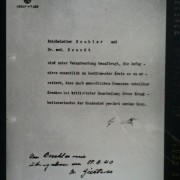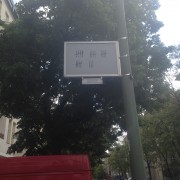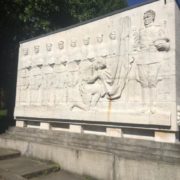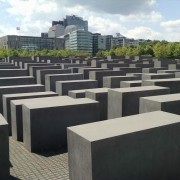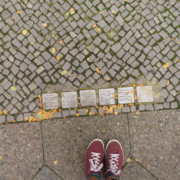Gleis 17: The Site of Deportation
By Emily Nestler
The purpose of observing and studying the European memorials devoted to the Holocaust is to learn and discover how Germany and Poland commemorate the victims and recognize the events that took place from 1933 with the rise of Hitler to 1945, the end of World War II and the liberation of the Jews. It has been an emotional journey as the sites we have visited acknowledge a time of inhumane practices and genocide perpetrated by the murderous regime of Nazi Germany. However, it has been an important and powerful experience as we try to understand that time period in order to remember those who have suffered and to prevent future atrocities. History is important and it is the obligation of the memorials and ourselves as educated persons to guarantee that no one can forget it.
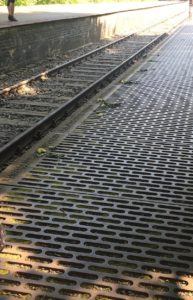 Naturally, specific memorials trigger different emotions for different people. For myself, the memorial at the Berlin Grunewald Train Station, Gleis 17 followed by the extermination camp, Auschwitz-Birkenau, have instilled in me a combined feeling of sorrow, anger and guilt. Track 17, located in the wealthy Grunewald district, was the train station that began the cruel process of deporting thousands of Jews to ghettos and concentration/death camps. The Deutsche Bahn, who ran the station compliant with the Nazi Regime, forced the deported to purchase their train ticket, climb into compact, crowded cars and look to an unknown and uncertain future. The men, women and children, not aware of where they were going, held on to a false hope as the train sped away. However, the hope dwindled with the realization that the train was simply an instrument of murder as most of them arrived at the merciless and inhumane camp, Auschwitz-Birkenau.
Naturally, specific memorials trigger different emotions for different people. For myself, the memorial at the Berlin Grunewald Train Station, Gleis 17 followed by the extermination camp, Auschwitz-Birkenau, have instilled in me a combined feeling of sorrow, anger and guilt. Track 17, located in the wealthy Grunewald district, was the train station that began the cruel process of deporting thousands of Jews to ghettos and concentration/death camps. The Deutsche Bahn, who ran the station compliant with the Nazi Regime, forced the deported to purchase their train ticket, climb into compact, crowded cars and look to an unknown and uncertain future. The men, women and children, not aware of where they were going, held on to a false hope as the train sped away. However, the hope dwindled with the realization that the train was simply an instrument of murder as most of them arrived at the merciless and inhumane camp, Auschwitz-Birkenau.
Approaching Track 17, I was unaware of what to expect because this location is not a common memorial known to the general public, an injustice to the people who have suffered there. However, as we stepped onto the platform, I attempted to imagine what it would have felt like to be standing there in 1942 where a majority of trains departing from this place ended up in Auschwitz-Birkenau. I imagined what I would have felt, what I would have seen or heard. I wondered what the people around me would be doing. Would I have seen utter chaos and panic? Or a calm, helpless acceptance of one’s fate? I was obviously unsuccessful in my attempt to recreate the scene and feeling of the Jews deported from this platform as it is impossible to completely and fully understand what they went through. However, the site conveyed a sense of sorrow and remembrance.
 The green trees blew in the wind overhead and below our feet, etched along the border of the platform were three pieces of information that proved pivotal in telling the story of what occurred here. Each section along the tracks began with a date, followed by a number and finished with a final destination. This detail along the tracks told the story of when a group of Jews were deported, how many were in the train that day and where that train was taking them. For example, on March 3rd, 1943, 1,732 Jewish people were deported from their homes in Berlin and taken to Auschwitz. Walking along the tracks and seeing a new set of dates, numbers and places every few steps compels you to remember the lives that were destroyed with the help of this station. Along the side lay several flowers, rocks and candles left by visitors further commemorating the lives destroyed in this spot. I wondered about the people who left those items memorializing what had happened there. Were they simply sympathizing with the people who suffered? Could it have been a German citizen apologizing for the actions of their ancestors? Or were they commemorating a friend or family member deported from this station? These items reveal that the lives destroyed due to the deportation of the Jews would never live in the past. People today continue to be affected by the infamous events that took place throughout the Holocaust and continue to remember the people who suffered. Although we did not personally witness the tragedy that took place in this very location and some may wonder how we can remember events we were never a part of, this track allows visitors to feel the sadness and sorrow of this time. Although we may not be able to comprehend the Deutsche Bahn’s compliancy and the aggressive deportation of thousands of innocent people, this station grants the people of today the powerful ability to feel a sense of sympathy. Standing on that platform facing an unknown destination, imagining yourself in the shoes of those who experienced these horrific acts, you have no choice but to feel compassion and heartbreak for the victims and a sense of guilt as you leave the station on your own terms. Fortunately, sympathy and compassion are powerful tools in ensuring that history will not and cannot repeat itself.
The green trees blew in the wind overhead and below our feet, etched along the border of the platform were three pieces of information that proved pivotal in telling the story of what occurred here. Each section along the tracks began with a date, followed by a number and finished with a final destination. This detail along the tracks told the story of when a group of Jews were deported, how many were in the train that day and where that train was taking them. For example, on March 3rd, 1943, 1,732 Jewish people were deported from their homes in Berlin and taken to Auschwitz. Walking along the tracks and seeing a new set of dates, numbers and places every few steps compels you to remember the lives that were destroyed with the help of this station. Along the side lay several flowers, rocks and candles left by visitors further commemorating the lives destroyed in this spot. I wondered about the people who left those items memorializing what had happened there. Were they simply sympathizing with the people who suffered? Could it have been a German citizen apologizing for the actions of their ancestors? Or were they commemorating a friend or family member deported from this station? These items reveal that the lives destroyed due to the deportation of the Jews would never live in the past. People today continue to be affected by the infamous events that took place throughout the Holocaust and continue to remember the people who suffered. Although we did not personally witness the tragedy that took place in this very location and some may wonder how we can remember events we were never a part of, this track allows visitors to feel the sadness and sorrow of this time. Although we may not be able to comprehend the Deutsche Bahn’s compliancy and the aggressive deportation of thousands of innocent people, this station grants the people of today the powerful ability to feel a sense of sympathy. Standing on that platform facing an unknown destination, imagining yourself in the shoes of those who experienced these horrific acts, you have no choice but to feel compassion and heartbreak for the victims and a sense of guilt as you leave the station on your own terms. Fortunately, sympathy and compassion are powerful tools in ensuring that history will not and cannot repeat itself.



